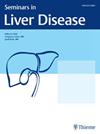Animal Models of Steatosis
IF 4.3
3区 医学
Q1 GASTROENTEROLOGY & HEPATOLOGY
引用次数: 455
Abstract
The lipid content of hepatocytes is regulated by the integrated activities of cellular enzymes that catalyze lipid uptake, synthesis, oxidation, and export. When "input" of fats into these systems (either because of increased fatty acid delivery, hepatic fatty acid uptake, or fatty acid synthesis) exceeds the capacity for fatty acid oxidation or export (i.e., "output"), then hepatic steatosis occurs. Genetic causes of increased fatty acid input promote excessive hepatic lipogenesis. These include mutations that cause leptin deficiency or leptin receptor inhibition and mutations that induce insulin, insulin-like growth factors, or insulin-responsive transcription factors. Genetic causes of impaired hepatic fatty acid oxidation inhibit the elimination (i.e., output) of fat from the liver. These include mutations that inhibit various components of the peroxisomal and/or mitochondrial pathways for fatty acid beta-oxidation. Environmental factors, such as diets and toxins, can also unbalance hepatic fatty acid synthesis and oxidation. Hepatic lipogenesis is increased by dietary sucrose, fructose, or fats and certain toxins, such as ethanol. Hepatic fatty acid oxidation is inhibited by choline- or methionine-deficient diets and other toxins, such as etomoxir. Animals with genetic or environmental induction of hepatic lipogenesis appear to be useful models for human nonalcoholic fatty liver disease in which hyperinsulinemia and defective leptin signaling are conspicuous at early stages of the disease process.脂肪变性动物模型
肝细胞的脂质含量受催化脂质摄取、合成、氧化和输出的细胞酶的综合活动调节。当脂肪“输入”到这些系统(由于脂肪酸输送、肝脏脂肪酸摄取或脂肪酸合成增加)超过脂肪酸氧化或输出(即“输出”)的能力时,就会发生肝脂肪变性。脂肪酸输入增加的遗传原因促进肝脏脂肪的过度生成。这些突变包括导致瘦素缺乏或瘦素受体抑制的突变,以及诱导胰岛素、胰岛素样生长因子或胰岛素反应性转录因子的突变。肝脂肪酸氧化受损的遗传原因抑制了肝脏脂肪的消除(即输出)。这些突变包括抑制脂肪酸-氧化的过氧化物酶体和/或线粒体途径的各种成分。环境因素,如饮食和毒素,也会使肝脂肪酸合成和氧化失衡。饮食中的蔗糖、果糖、脂肪和某些毒素(如乙醇)可增加肝脏脂肪生成。缺乏胆碱或蛋氨酸的饮食和其他毒素(如依托莫昔)可抑制肝脂肪酸氧化。遗传或环境诱导肝脏脂肪生成的动物似乎是人类非酒精性脂肪性肝病的有用模型,其中高胰岛素血症和瘦素信号缺陷在疾病过程的早期阶段是明显的。
本文章由计算机程序翻译,如有差异,请以英文原文为准。
求助全文
约1分钟内获得全文
求助全文
来源期刊

Seminars in liver disease
医学-胃肠肝病学
CiteScore
8.20
自引率
2.40%
发文量
38
期刊介绍:
Seminars in Liver Disease is a quarterly review journal that publishes issues related to the specialties of hepatology and gastroenterology.
As the premiere review journal in the field, Seminars in Liver Disease provides in-depth coverage with articles and issues focusing on topics such as cirrhosis, transplantation, vascular and coagulation disorders, cytokines, hepatitis B & C, Nonalcoholic Steatosis Syndromes (NASH), pediatric liver diseases, hepatic stem cells, porphyrias as well as a myriad of other diseases related to the liver. Attention is also given to the latest developments in drug therapy along with treatment and current management techniques. Seminars in Liver Disease publishes commissioned reviews. Unsolicited reviews of an exceptional nature or original articles presenting remarkable results will be considered, but case reports will not be published.
 求助内容:
求助内容: 应助结果提醒方式:
应助结果提醒方式:


